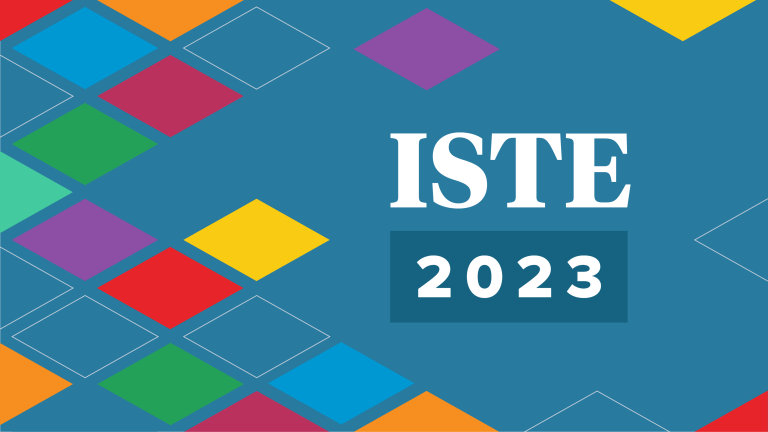One theme is clear after ISTE in Philadelphia this year, artificial intelligence (AI) is on everyone’s mind. We were there listening and taking notes, and we walked away with a deeper understanding of where AI is today, how educators use it, the concerns surrounding it, and a glimpse into its future and impact on education.
Here are the top ten AI learnings we’re holding onto as we move forward.
1. AI is here to stay.
And it’s already been here for a while–from the development of computers in the 60s to tools like Alexa, Siri, Spotify, and Waze. It has been shaping the way we work, communicate, and learn. Over the last six months, the democratization of generative AI tools (such as ChatGPT and Google Bard) has reignited the conversation. Still, educators need to know that this technology didn’t appear overnight, likely won’t disappear soon, and will continue to advance exponentially.
2. We’ve successfully navigated new technology in education before and can do it again.
If the past holds any wisdom for the present, the current excitement and fear surrounding artificial intelligence are normal.
With the onset of the calculator, many wondered if students would still need to know how to compute equations. With spellcheckers, Language Arts teachers worried if they still needed to teach grammar mechanics. The internet came with a wave of excitement and anxiety. How do we responsibly access all of the information available? Is using these tools plagiarism? With the passage of time and a greater understanding of technology, we now know how these tools elevate students’ learning journeys; AI will likely follow a similar trajectory.
3. Human-centered AI can support educators.
In the ISTE closing keynote, Kevin Roose, award-winning author and tech columnist for the New York Times, said, “Humanity is the great differentiator. We have to focus on creativity, compassion, and courage...AI will change the world, but the value of human skills will only increase.”
Human intelligence (HI) and the skills that differentiate humans from machines–compassion, courage, critical thinking, and computational thinking–remain essential for creating personalized learning experiences. When creating assignments, educators should think about how to incorporate generative AI tools as a starting point to unlock students’ curiosity, creativity, and higher-level thinking skills.
4. We need to foster digital citizenship in every student.
While generative AI technologies are excellent at producing a high volume of content at a moment’s notice, it’s important to remember that students can’t learn integrity from this same technology.
Humans teach, define, and foster integrity, and with the influx of information in the hands of students, it will be paramount that we teach students how to use these tools responsibly.
We also heard about the amplified need for digital discernment—the ongoing process of determining which information is and isn’t trustworthy.
5. Accessibility and equitability should be primary concerns.
Every educational tool—AI-powered or not—should aim to level the playing field for all students. Similarly, we need to hear voices from every community as we explore what the future classrooms will look like with AI.
Some educators envision AI being a support system for struggling students that meets them wherever they are and gives feedback when they need it. Others see it as the assistant for busy teachers, making their lives easier so they can focus on the parts of teaching that are most important. To make that reality, we need to empower advocates from all educational communities to speak to the potential power of AI.
6. Educators need to be learners in this AI discovery phase.
We can’t underestimate the magnitude of this moment with AI. One educator put it like this, “The ground is being shaken, and the majority of people are caught in the middle. We need to hit pause and figure out what’s going on. How do I learn on the fly? What resources are there?”
We heard another educator share,” I’m committed to going to all the AI sessions so I can be a better teacher to my students.”
Simply put, educators are facing a fresh opportunity to be a student. Students' lives are more likely than not going to be filled with AI; it’s imperative that teachers see for themselves what these tools can (and can’t) do to best set students up for success.
7. AI can accelerate workflows but never replace teachers.
“It’s not about learning as fast as we can, but learning in a meaningful, streamlined way,” Nancye Blair Black said in the Fireside Chat, AI and Learning.
The reality is that AI can expedite some aspects of a teacher’s job. The tools cannot replicate all the nuances of a teacher’s role. However, if executed mindfully, AI can streamline many day-to-day tasks like drafting email communications, brainstorming lesson plans, and personalizing activities.
8. Classrooms need to discuss AI openly.
Another educator shared, “Today’s teachers teach the best technology we’ve ever had. And today’s students learn with the worst technology they’ll ever use.”
Because AI will be a part of our students’ lifelong learning journey, classrooms must be safe spaces to discuss it. Teachers can learn firsthand about how students are experiencing AI, what they’re excited about, their concerns, and how they’ve used the technology so far. Open conversations - rather than hard bans - can help everyone learn together.
9. We must teach students how to harness the power of generative AI.
Although the world of AI is still being crafted, we need to start teaching students how to work on hybrid teams—comprised of part human and part AI—because most students will be collaborating with AI in their careers. We should have open conversations with students about technology, including its potential and limitations. Additionally, we must underscore to students that generative AI is not a magical tool with all the answers and instead teach them how they can utilize it to support or supplement their learning.
10. Thoughtful prompt engineering is critical to success.
We can start conversations with students by showing them how to use AI to brainstorm, become masters at content curation, and lead with strategy and higher-level thinking.
Monica Burns emphasized the importance of tone, context, and specificity when interacting with generative AI tools. The more context we can provide tools on the front end, the more likely we will receive the needed content. And we should always see the output as a draft.
The AI Road Ahead
There is no doubt that we are still in the beginning of the story of how AI will influence, empower, and support aspects of teaching and learning. While there is justified hesitancy around the role that AI will play, we also see equal excitement amongst educators as they see the power it has.
ISTE was an incredible opportunity to listen and learn. As we continue exploring generative AI, we are guided by our mission to elevate student success, amplify the power of teaching, and inspire everyone to learn together. Learn more about how to empower educators and students with boundaries in AI.

